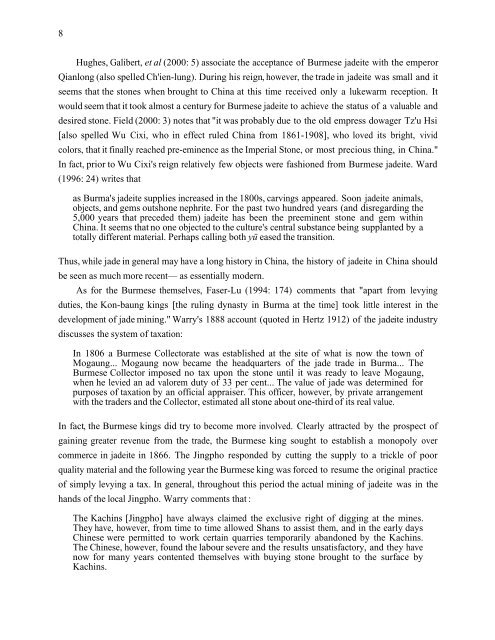JADEITE - Canadian Institute of Gemmology
JADEITE - Canadian Institute of Gemmology
JADEITE - Canadian Institute of Gemmology
Create successful ePaper yourself
Turn your PDF publications into a flip-book with our unique Google optimized e-Paper software.
8<br />
Hughes, Galibert, et al (2000: 5) associate the acceptance <strong>of</strong> Burmese jadeite with the emperor<br />
Qianlong (also spelled Ch'ien-lung). During his reign, however, the trade in jadeite was small and it<br />
seems that the stones when brought to China at this time received only a lukewarm reception. It<br />
would seem that it took almost a century for Burmese jadeite to achieve the status <strong>of</strong> a valuable and<br />
desired stone. Field (2000: 3) notes that "it was probably due to the old empress dowager Tz'u Hsi<br />
[also spelled Wu Cixi, who in effect ruled China from 1861-1908], who loved its bright, vivid<br />
colors, that it finally reached pre-eminence as the Imperial Stone, or most precious thing, in China."<br />
In fact, prior to Wu Cixi's reign relatively few objects were fashioned from Burmese jadeite. Ward<br />
(1996: 24) writes that<br />
as Burma's jadeite supplies increased in the 1800s, carvings appeared. Soon jadeite animals,<br />
objects, and gems outshone nephrite. For the past two hundred years (and disregarding the<br />
5,000 years that preceded them) jadeite has been the preeminent stone and gem within<br />
China. It seems that no one objected to the culture's central substance being supplanted by a<br />
totally different material. Perhaps calling both yü eased the transition.<br />
Thus, while jade in general may have a long history in China, the history <strong>of</strong> jadeite in China should<br />
be seen as much more recent— as essentially modern.<br />
As for the Burmese themselves, Faser-Lu (1994: 174) comments that "apart from levying<br />
duties, the Kon-baung kings [the ruling dynasty in Burma at the time] took little interest in the<br />
development <strong>of</strong> jade mining." Warry's 1888 account (quoted in Hertz 1912) <strong>of</strong> the jadeite industry<br />
discusses the system <strong>of</strong> taxation:<br />
In 1806 a Burmese Collectorate was established at the site <strong>of</strong> what is now the town <strong>of</strong><br />
Mogaung... Mogaung now became the headquarters <strong>of</strong> the jade trade in Burma... The<br />
Burmese Collector imposed no tax upon the stone until it was ready to leave Mogaung,<br />
when he levied an ad valorem duty <strong>of</strong> 33 per cent... The value <strong>of</strong> jade was determined for<br />
purposes <strong>of</strong> taxation by an <strong>of</strong>ficial appraiser. This <strong>of</strong>ficer, however, by private arrangement<br />
with the traders and the Collector, estimated all stone about one-third <strong>of</strong> its real value.<br />
In fact, the Burmese kings did try to become more involved. Clearly attracted by the prospect <strong>of</strong><br />
gaining greater revenue from the trade, the Burmese king sought to establish a monopoly over<br />
commerce in jadeite in 1866. The Jingpho responded by cutting the supply to a trickle <strong>of</strong> poor<br />
quality material and the following year the Burmese king was forced to resume the original practice<br />
<strong>of</strong> simply levying a tax. In general, throughout this period the actual mining <strong>of</strong> jadeite was in the<br />
hands <strong>of</strong> the local Jingpho. Warry comments that :<br />
The Kachins [Jingpho] have always claimed the exclusive right <strong>of</strong> digging at the mines.<br />
They have, however, from time to time allowed Shans to assist them, and in the early days<br />
Chinese were permitted to work certain quarries temporarily abandoned by the Kachins.<br />
The Chinese, however, found the labour severe and the results unsatisfactory, and they have<br />
now for many years contented themselves with buying stone brought to the surface by<br />
Kachins.









